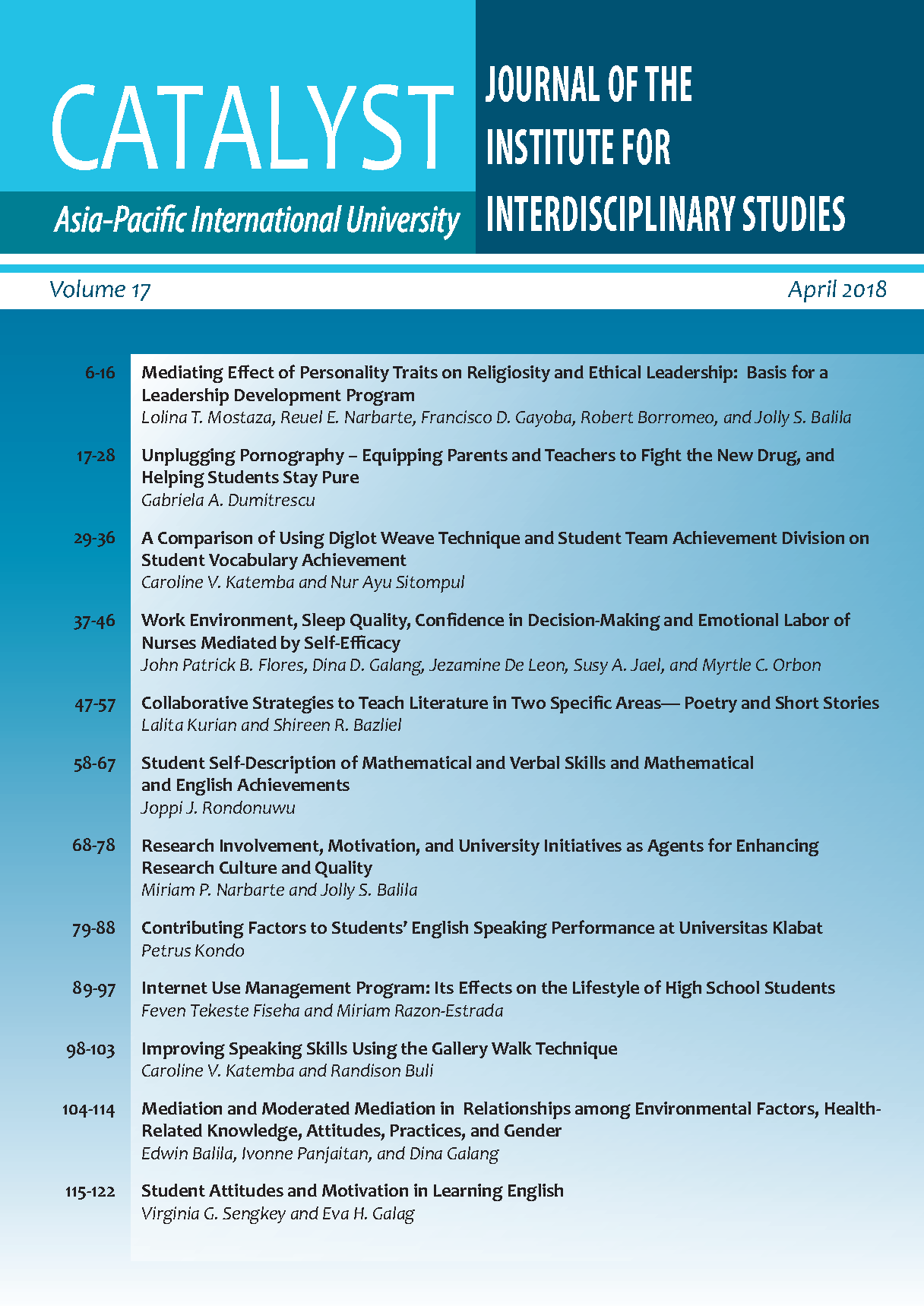A Comparison of Using Diglot Weave Technique and Student Team Achievement Division on Student Vocabulary Achievement
Main Article Content
Abstract
The first aim of this study was to find out the differences in student’s vocabulary achievement between students who were taught using the Diglot Weave Technique (DWT), and those taught using a Student Team Achievement Division (STAD) strategy; the second was to find which gender group gained the higher score. This comparative study was completed at Public Junior High School #1 (Sekolah Menengah Pertama Negeri – SMPN), Parongpong, Bandung, West Java, Indonesia, and involved two groups, one from grade 8B as the DWT class, and another from grade 8C as the STAD class. Total participants were 74 students. The DWT group consisted of 26 females and 11 males, and the STAD group consisted of 23 females and 14 males. Based on an SPSS 16.0 data analysis, a ρ value of 0.035 < 0.05 was obtained. The significantly higher score was achieved when students were taught using DWT. Furthermore, it was found that, with both methods, female and male’ normalized gain scores were only slightly different.
Article Details

This work is licensed under a Creative Commons Attribution-NonCommercial-NoDerivatives 4.0 International License.
Copyright: Asia-Pacific International University reserve exclusive rights to publish, reproduce and distribute the manuscript and all contents therein.
References
Braze, D., Tabor, W., Shankweiler, D., & Mencl, W. (2007). Speaking up for vocabulary: reading skill differences in young adults. Journal of Learning Disabilities, 40(3), 226-243. Retrieved from http://www.haskins.yale.edu/ reprints/hl1464.pdf
Furqon, F. (2013). Correlation between students’ vocabulary mastery and their reading comprehension. Journal of English and Education, 1(1), 68-80. Retrieved from https://media.neliti.com/media/publications/192696-EN-none.pdf
Huyen, N., & Nga, K. (2003). Learning vocabulary through games: the effectiveness of learning vocabulary through games. ASIAN EFL Journal, 5(4). Retrieved from http://asian-efljournal.com/dec_03_vn.pdf.
Ivone, M. (2005). Teaching English as a foreign language in Indonesia: the urge to improve classroom vocabulary instruction. TEFLIN Journal, 16(2), August 2005. Retrieved from: http://www.teflin.org/journal/index.php/ journal/article/viewFile/74/70.
Jingxia, L. (2008). How much the first language is there in Teachers’ talk in EFL classroom? The Open Applied Linguistics Journal, 1, 59-67. Retrieved from https://benthamopen.com/contents/pdf/TOALJ/TOALJ-1-59.pdf
Kashani, S., & Shafiee, S. (2016). A comparison of vocabulary learning strategies among elementary Iranian EFL learners. Journal of Language Teaching and Research, 7(3), 511-518. Retrieved from http://dx.org/ 10.17507/ jltr.0703.11.
Katemba, C. (2013). Anxiety Level of Indonesian Students and Its Relationship to Academic Achievement in English. Journal of Education and Practice Vol. 4 No. 27. Retrieved from http://www.iiste.org/Journals/index.php/ JEP/article/ view/9873/10097.
Katemba, C. & Tampubolon (2011). Improving Vocabulary Achievement through Total Physical Response among Grade Four Elementary School Pupils. Journal of Language Pedagogy Vol. 1 No. 2. Retrieved from http://jurnal.unai.edu/ index.php/pedagogy/article/view/356.
Lightbown, P. (2001). L2 instruction: time to teach. TESOL Quarterly, 35(4), 598-599.
Moodley, V. (2007). Code switching in the multilingual English first language classroom. International Journal of Bilingual Education & Bilingualism, 10(6), 707-722.
Muhammad, H. (2012). On the importance of English language education for students. Jakarta Post Website. Retrieved from: https://www.pressreader.com/indonesia/thejakartapost/20121029/282093453991686.
Mukoroli, J. (2011). Effective Vocabulary Teaching Strategies for the English for Academic Purposes ESL Classroom. SIT Graduate Institute: MA TESOL Collection, Paper 501. Retrieved from http://digitalcollections.sit.edu/cgi/ viewcontent.cgi?article=1503&context=ipp_collection.
Nemati, A., Malekib, E. (2014). The effect of teaching vocabulary through the diglot weave technique on vocabulary learning of Iranian high school students. Procedia – Social and Behavioral Sciences, 98, 1340-1345.
Novitasari, D. (2013). Pengaruh slap game word pada siswa vocabulary mastery di SMPN 2 Jatirejo Mojokerto. Online Library UIN Sunan Ampel Surabaya. Retrieved from: http://digilib.uinsby.ac.id/11302/
Priz, Leon. Second Language Acquisition. (2015). Leon’s Planet Website. Retrieved from: http://leonsplanet.com/ eng_ped.htm.
Samani, S., & Narafshan, M. (2016). Students' strategic reactions to the role of native language as a medium of instruction in English classrooms. Journal of Language Teaching and Research, 7(4), 716-723.
Slavin, R. (1995). Cooperative Learning: Theory, research and practice (2nd Ed). USA: A Simon & Schuster Company.
Subon, F. (2016). Direct vocabulary instruction: the effects of contextualized word families on learners’ vocabulary acquisition. Procedia – Social and Behavioral Science, 224, 284-291.
Thornbury, S. (2002). How to teach vocabulary. England: Longman.
Thuy, N. (2010). The effects of semantic mapping on vocabulary memorizing. Foreign Language Learning and Teaching, 2, 628- 659. Retrieved from www.litu.tu.ac.th/journal/FLLTCP/Proceeding/628.pdf.
Windasari, Rita, F. Salehuddin (2016). Improving English Vocabulary Mastery of Grade VIII students Through Student Team Achievement Division (STAD). E-Journal of English Language Teaching Society (ELTS) Vol 4. No 2, 2016 ISSN 2331-1841 p. 1-12.
Yuhua, J. (1999). In the Classroom: Communicative language- teaching through sandwich stories for EFL children in china. TESL CANADAJOURNAUREVUE TESL DU CANADA, 17, (1). Retrieved from https://files.eric.ed.gov/ fulltext/EJ597414.pdf.


